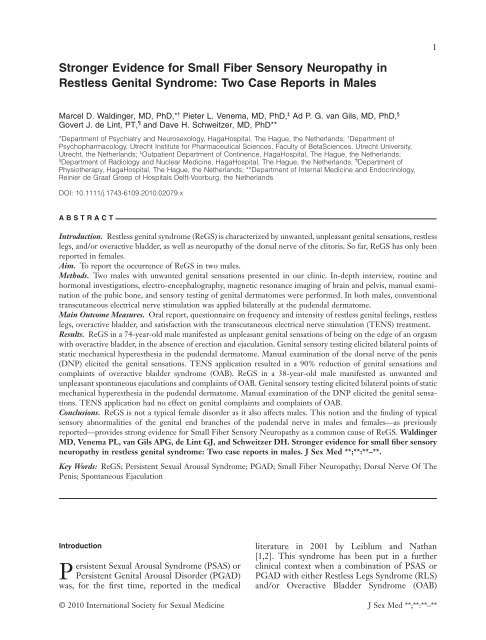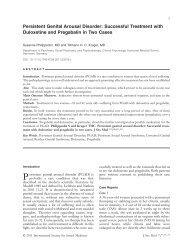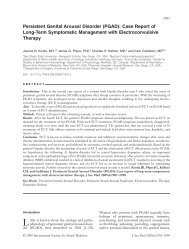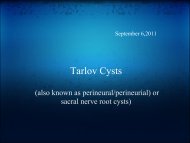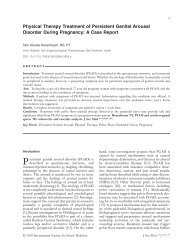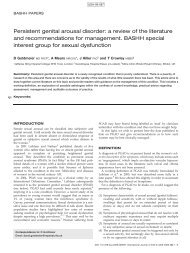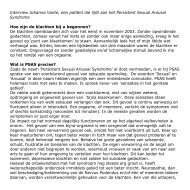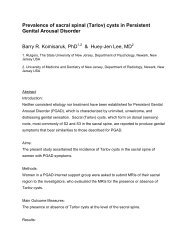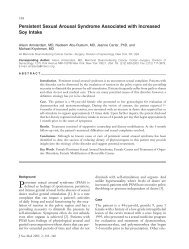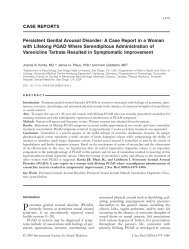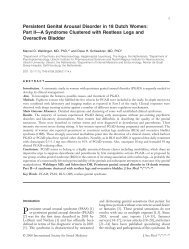Stronger Evidence for Small Fiber Sensory ... - PGAD Support
Stronger Evidence for Small Fiber Sensory ... - PGAD Support
Stronger Evidence for Small Fiber Sensory ... - PGAD Support
You also want an ePaper? Increase the reach of your titles
YUMPU automatically turns print PDFs into web optimized ePapers that Google loves.
1<strong>Stronger</strong> <strong>Evidence</strong> <strong>for</strong> <strong>Small</strong> <strong>Fiber</strong> <strong>Sensory</strong> Neuropathy inRestless Genital Syndrome: Two Case Reports in Malesjsm_2079 1..6Marcel D. Waldinger, MD, PhD,* † Pieter L. Venema, MD, PhD, ‡ Ad P. G. van Gils, MD, PhD, §Govert J. de Lint, PT, and Dave H. Schweitzer, MD, PhD***Department of Psychiatry and Neurosexology, HagaHospital, The Hague, the Netherlands; † Department ofPsychopharmacology, Utrecht Institute <strong>for</strong> Pharmaceutical Sciences, Faculty of BetaSciences, Utrecht University,Utrecht, the Netherlands; ‡ Outpatient Department of Continence, HagaHospital, The Hague, the Netherlands;§Department of Radiology and Nuclear Medicine, HagaHospital, The Hague, the Netherlands; Department ofPhysiotherapy, HagaHospital, The Hague, the Netherlands; **Department of Internal Medicine and Endocrinology,Reinier de Graaf Groep of Hospitals Delft-Voorburg, the NetherlandsDOI: 10.1111/j.1743-6109.2010.02079.xABSTRACTIntroduction. Restless genital syndrome (ReGS) is characterized by unwanted, unpleasant genital sensations, restlesslegs, and/or overactive bladder, as well as neuropathy of the dorsal nerve of the clitoris. So far, ReGS has only beenreported in females.Aim. To report the occurrence of ReGS in two males.Methods. Two males with unwanted genital sensations presented in our clinic. In-depth interview, routine andhormonal investigations, electro-encephalography, magnetic resonance imaging of brain and pelvis, manual examinationof the pubic bone, and sensory testing of genital dermatomes were per<strong>for</strong>med. In both males, conventionaltranscutaneous electrical nerve stimulation was applied bilaterally at the pudendal dermatome.Main Outcome Measures. Oral report, questionnaire on frequency and intensity of restless genital feelings, restlesslegs, overactive bladder, and satisfaction with the transcutaneous electrical nerve stimulation (TENS) treatment.Results. ReGS in a 74-year-old male manifested as unpleasant genital sensations of being on the edge of an orgasmwith overactive bladder, in the absence of erection and ejaculation. Genital sensory testing elicited bilateral points ofstatic mechanical hyperesthesia in the pudendal dermatome. Manual examination of the dorsal nerve of the penis(DNP) elicited the genital sensations. TENS application resulted in a 90% reduction of genital sensations andcomplaints of overactive bladder syndrome (OAB). ReGS in a 38-year-old male manifested as unwanted andunpleasant spontaneous ejaculations and complaints of OAB. Genital sensory testing elicited bilateral points of staticmechanical hyperesthesia in the pudendal dermatome. Manual examination of the DNP elicited the genital sensations.TENS application had no effect on genital complaints and complaints of OAB.Conclusions. ReGS is not a typical female disorder as it also affects males. This notion and the finding of typicalsensory abnormalities of the genital end branches of the pudendal nerve in males and females—as previouslyreported—provides strong evidence <strong>for</strong> <strong>Small</strong> <strong>Fiber</strong> <strong>Sensory</strong> Neuropathy as a common cause of ReGS. WaldingerMD, Venema PL, van Gils APG, de Lint GJ, and Schweitzer DH. <strong>Stronger</strong> evidence <strong>for</strong> small fiber sensoryneuropathy in restless genital syndrome: Two case reports in males. J Sex Med **;**:**–**.Key Words: ReGS; Persistent Sexual Arousal Syndrome; <strong>PGAD</strong>; <strong>Small</strong> <strong>Fiber</strong> Neuropathy; Dorsal Nerve Of ThePenis; Spontaneous EjaculationIntroductionPersistent Sexual Arousal Syndrome (PSAS) orPersistent Genital Arousal Disorder (<strong>PGAD</strong>)was, <strong>for</strong> the first time, reported in the medicalliterature in 2001 by Leiblum and Nathan[1,2]. This syndrome has been put in a furtherclinical context when a combination of PSAS or<strong>PGAD</strong> with either Restless Legs Syndrome (RLS)and/or Overactive Bladder Syndrome (OAB)© 2010 International Society <strong>for</strong> Sexual Medicine J Sex Med **;**:**–**
2 Waldinger et al.and/or hypersensitivity of the urethra has beencalled Restless Genital Syndrome (ReGS), asdescribed by Waldinger et al. [3–7]. In two systematicstudies [3,5], it was found that ReGS is characterizedby unwanted and unpleasant genitalsensations, e.g., dysesthesias and/or paresthesias,which are often felt as feelings of an imminentorgasm in the absence of sexual desire or fantasiesand/or are often perceived as a sort of “restlessness”in and around the genitals. Moreover, the persistentpresence of dysesthesias often results in agitationand restlessness. Rather rarely, ReGS may also giverise to unpleasantly experienced spontaneousorgasms [3–7]. In addition, ReGS usually occurs inperimenopausal and postmenopausal women, butmay also affect premenopausal women, <strong>for</strong>example, premenstrually or temporarily duringpregnancy [3–7]. ReGS is highly associated withrestless legs and complaints of overactive bladder,aggravates during sitting, and has the clinical characteristicsof small fiber sensory neuropathy(SFSN) of the dorsal nerve of the clitoris (DNC)[5]. In the majority of women with ReGS, magneticresonance imaging (MRI) scans of the pelvis showmild to moderate varices in the vagina, labia minoraand/or majora, and uterus [3–7]. ReGS is neitherassociated with premorbid psychiatric disorderslike major depression, anxiety disorders, or obsessivecompulsive disorder, nor with previous sexualabuse [3–5]. However, nearly all of the womenaffected by ReGS report varying degrees of socialwithdrawal, desperate feelings, dysthymia, agitation,restlessness, depressed mood, and, sometimes,suicidal thoughts [3–7]. It has been postulated thatSFSN of the DNC is the key feature of ReGS [5]and may give rise to associated restless legs andcomplaints of overactive bladder [5]. Preliminaryresearch suggests that transcutaneous electricalnerve stimulation (TENS) in the genital regionmay lead to a diminishment of symptoms of SFSN[7]. Since its first description in literature, PSAS or<strong>PGAD</strong> has been considered a typical female sexualdisorder [8]. However, and in contrast, althoughReGS has so far only been reported in females, ithas never been claimed to be a typical female sexualdisorder. In the current report of two male patients,it will be argued that ReGS and, there<strong>for</strong>e, also thetypical unwanted genital sensations of <strong>PGAD</strong>, mayalso occur in males.Materials and MethodsWe prospectively evaluated two males with complaintsof persistent unwanted feelings of genitalrestlessness, imminent orgasm, and/or spontaneousejaculations who visited our OutpatientDepartment of Neurosexology in The Hague.Both males were not actively recruited but werereferred by their general physician and urologist,respectively. According to the regulations of themedical ethical committee, official permission <strong>for</strong>study participation was not required as the studywas not placebo controlled and study drugs werenot taken. Both patients were investigated by thefirst author, who followed an evaluation procedureaccording to standard protocol <strong>for</strong> the diagnosisand treatment of ReGS. After a neuropsychiatricand medical sexological interview of about 1 hour,both males who were clinically diagnosed ashaving ReGS underwent routine and hormonallaboratory testing, an EEG, an MRI scan examinationof the brain and pelvis, and an ultrasoundexamination of the scrotum.The diagnosis ReGS was established when thesymptoms of the patients fulfilled a number of sevencriteria of ReGS being (i) unwanted and unpleasantrestless genital feelings in absence of sexual desire orsexual fantasies; and/or (ii) unwanted and unpleasantspontaneous orgasms in absence of sexual desire orsexual fantasies; and/or (iii) complaints of restlesslegs syndrome; and/or (iv) complaints of overactivebladder syndrome; and/or (v) aggravation ofunwanted and unpleasant restless genital feelings bysitting; and (vi) static mechanical hyperesthesia ofgenital region on sensory testing; and (vii) triggeringof unwanted and unpleasant genital sensations bymanual examination of the ramus inferior of thepubic bone (RIPB) [7].The diagnosis restless legs syndrome was establishedaccording to the criteria of the InternationalRestless Legs Syndrome Study Group [9].Physical examination included sensory testing ofthe genital region and manual examination of theRIPB [5]. This was per<strong>for</strong>med by a urologist (secondauthor) in the presence of the first author and anurse. The test <strong>for</strong> tactile sensations of the genitalregion is designed to analyze static mechanicalhyperesthesia using light pressure with a cotton swabat the skin near the vicinity of the genitals, perineum,anal area, groins, and pubic bone [5].Conventional TENS was applied and explainedby a physiotherapist (fourth author), in the presenceof the first author and a nurse. The physiotherapistcleaned the skin with alcohol. With asurface electrode (test probe) the skin area at thepubic bone, genital area, and sacral region wasinvestigated <strong>for</strong> the point at which ReGS symptomsmost noticeably diminished after applicationJ Sex Med **;**:**–**
Restless Genital Syndrome in Two Males 3of TENS. At this point, a surface electrode(40 ¥ 40 mm: DE-01 van Lent Systems B.V., Oss,the Netherlands) with adhesive gel was placed. Asecond electrode was placed at the pubic bone atthe origin of the penis. Both electrodes wereattached to a single channel of an i-Pulz TENSapparatus (Van Lent Systems B.V.) set at a frequencyof 110 Hz and a pulse-width of 80 ms,indicating high-frequency TENS or conventionalTENS. The intensity of the stimulation wasgradually increased to optimize therapy efficacy,thereby avoiding overstimulation. At home,patients could vary the intensity (mA) but not thefrequency and pulse width of the electrical current.The first application of high frequency TENSwas a 20-minute trial period in which a beneficialeffect of TENS was investigated. In case thepatient reported less ReGS sensations, he wasinstructed in self-administration of the TENSdevice. Both males were instructed to use TENS athome <strong>for</strong> 1 hour, seven times per day, spaced atregular intervals of 1 hour. During a 2–4-weekperiod, readjustments of the stimulation variables(frequency and pulse width) were allowed. Afterthis period, the effect of TENS was evaluated <strong>for</strong>an additional month, and the decision was madewhether or not to continue with TENS.Follow-up visits took place at regular intervals.A questionnaire designed by the first author wasused to assess the patient perception of improvementby TENS application. It contained two questionson the severity and frequency of unwantedgenital complaints per week, a question to expressthe severity of unwanted genital complaints on ascale of 0–10, with 0 being “no complaints at all”and 10 being “the worst complaints you canimagine,” and a question to express the intensity ofunwanted genital sensations on a visual analogscale on a 10-cm line.All published data in the current study were inagreement with the participants and both malesprovided written in<strong>for</strong>med consent <strong>for</strong> publicationof their data.Case Report AMr. A. is a 74-year-old married man with threechildren. He was referred to our outpatientdepartment by his general physician. His medicalhistory revealed a laparoscopic radical prostatectomydue to local prostatic carcinoma at the age of73 years. After surgery, continence remainednormal with no problems of micturition, ejaculationdisappeared but with intact sensations o<strong>for</strong>gasm, and previously existing erectile difficultiesbecame complete. Seven months after prostatectomy,Mr. A began to feel an increased “veryunpleasant” sexual urge in his genitals as if he is onthe edge of getting an orgasm in the absence ofconscious thoughts or fantasies about sex. Thesegenital sensations are experienced as a sort of“restlessness” in the genital area. These sensationswere very disturbing and unwanted, making thepatient feel upset, irritable, restless, and desperate.Although Mr. A and his wife accepted the loss oferectile function and abstained from sexual activitysince prostatectomy, he attempted to masturbatesimply to get rid of the genital sensations.However, after masturbation attempts, theunwanted genital sensations typically re-occurredwithin 15 minutes against his will. The genitalsensations got worse when sitting and diminishduring walking or lying down. Since the onset ofthe genital sensations, the patient recorded anincreased urgency to void, but only in smallamounts. Mr. A did not report restless legs. Sincehis prostatectomy, Mr. A has developed completeerectile dysfunction and anejaculation. Prior to hisprostatectomy, intercourse frequency was once aweek with an estimated intravaginal ejaculationlatency time (IELT) of about 10 minutes.However, since the onset of the genital feelings, asensation of orgasm occurs 20–60 seconds afterstart of masturbation. The weird sensations aredescribed as a type of tingling and are locatedabove the pubic bone, and along the penis ortestes. The sensations are triggered by touch of theglans penis along his clothes (allodynia), sitting,and after defecation. His medical history does notreveal prior child abuse, mood or anxiety disorder,obsessive compulsive disorder, or traumatic sexualexperiences. Mr. A was not complaining of sensationsof heaviness or dragging-like or aching painwithin the scrotum. Routine laboratory assessmentsin our hospital, including thyroid and hormonalscreen, were normal, and EEG and MRIscan of the brain showed no abnormalities. Ultrasoundexamination and an MRI scan of the pelvisshowed a varicocele at the inguinal canal bilaterally,but mainly at the left side, and around thespermatic cords. <strong>Sensory</strong> testing of the genitalregion elicited a considerable number of points ofstatic mechanical hyperesthesia bilaterally of thepubic bone, and above the penis in the pudendaldermatome (Figure 1A). Manual examination ofRIPB and, particularly along the dorsal nerve ofthe penis (DNP), elicited the sensations of animminent ejaculation and sensation of restlessnessat the previously mentioned trigger points. Mr. AJ Sex Med **;**:**–**
4 Waldinger et al.ABFigure 1 Points of static mechanical hyperesthesia in the pudendal dermatome and triggering points of unwanted genitalsensations along the ramus inferior of the pubic bone in Patient A (Figure 1A) and Patient B (Figure 1B).agreed with treatment with TENS, which he preferredover antiepileptics, antidepressants, or painkillers,including opiates that are often prescribed<strong>for</strong> neuropathies. Within 1 week, TENS treatmentresulted in a clinically very relevant reductionof ReGS sensations of about 90% anddisappearance of OAB complaints. Mr. A. reportedthat the daily and frequent use of TENS was notperceived as bothersome or interfering with hisdaily activities.Case Report BMr. B. is a 38-year-old married man who has twochildren. He was referred to our outpatientdepartment by a urologist. Apart from a sterilizationat the age of 36, his medical history is unremarkable.Mr. B. reports spontaneous ejaculationthat started at the age of 34 years. These spontaneousejaculations occur when sitting behind hisdesk at work, during driving a car, or during sportsin the absence of sexual arousal or an erection.Since the onset of these spontaneous ejaculations,he feels increased urgency to void but only smallamounts. The spontaneous ejaculations occuronce to three times a day and are accompanied byan unpleasant genital sensation of restlessness.They are triggered by sitting, defecation, micturition,and a cold environment. Notably, the spontaneousejaculations are not accompanied by anerection and/or feelings of orgasm. After an ejaculation,feelings of an imminent ejaculation reoccurafter 1–1.5 hours. Mr. B. does not report pain ornumb feelings in the genital region nor does hereport sensations of restless legs. During sexualactivity, he has no erectile difficulties and his sexualdesire and ejaculation are without any problems.His medical history does not reveal prior childabuse, mood or anxiety disorder, obsessive compulsivedisorder, or traumatic sexual experiences.Cystoscopy and investigations of the prostate andsemen per<strong>for</strong>med by the referring urologist wereunremarkable. Routine laboratory assessments inour hospital, including thyroid and hormonalscreen, were normal. An ECHO of the scrotum, anEEG, and MRI scan of the brain and of the pelvisshowed no abnormalities. <strong>Sensory</strong> testing of thegenital region elicited a few points of staticmechanical hyperesthesia on the left and right sideof the pubic bone and on the left side above thepenis in the pudendal dermatome (Figure 1B).Manual examination of RIPB, and particularlyalong the course of the dorsal nerve of the penis,elicited sensations of an imminent ejaculation atthe a<strong>for</strong>ementioned genital points. Mr. B. agreedwith treatment with TENS, as multiple drug treatmentshad no effect. However, TENS treatmentdid not result in any disappearance of his genitalcomplaints.DiscussionThe reported unwanted, unpleasant restlessgenital sensations of arousal, feelings of imminentejaculations, and/or occurrence of spontaneousejaculations, genital allodynia combined with thefinding of hyperesthesia in the dermatome of theJ Sex Med **;**:**–**
Restless Genital Syndrome in Two Males 5DNP including triggering of the unpleasantgenital sensations by manual pressure along theramus inferior of the pubic bone, are indicative ofSFSN of the DNP. As the unwanted genital sensationswere aggravated by sitting, and were associatedwith complaints of overactive bladder, bothmales were diagnosed as suffering from ReGS.The absence of restless legs in both males doesnot contradict the diagnosis of ReGS. ReGS is,by definition, a clinical syndrome of dysesthesiasin the surrounding of the genitals, which imperativelyleads to restless genital sensations. ReGS,according to its definition, is frequently but notobligatory present.Similar to the DNC, the DNP emerges from thepudendal nerve (PN) approximately 1 cm dorsal toits entrance into the pudendal canal [10]. Afterleaving the pudendal canal, the DNP runs in thesulcus nervi dorsalis penis (SNDP) at the inferiorramus and anteroinferior surface of body of pubistoward the dorsum penis, where it branches andinnervates the penile shaft and glans penis. Similarto the DNC, the DNP is a solely sensory nerve [10].It is of note that ReGS in the male should bedistinguished from the clinical symptoms ofentrapment of the DNP under the pubis, in theSNDP or in the pudendal canal, like glans and/orpenile insensitivity, genital and/or perineal pain ornumbness, and erectile difficulties as can beobserved in cyclists [11–13]. These symptomswere not reported nor present in the currentlyreported patients. Although there are strong indicationsof SFSN of the DNP, the cause of itsoccurrence in both males remains unknown. Interestingly,both males experienced either a morerapid sensation of orgasm (case A) or even spontaneousejaculations (case B). A relationshipbetween the DNP and premature ejaculation hasrecently been considered in a Chinese study inwhich men with PE appeared to have morebranches of the DNP [14]. However, as theChinese study did not provide quantitative data ofthe IELT, it remains questionable whether PE inthese men was diagnosed according to the ISSMdefinition of lifelong PE, in which the IELT is lessthan or about 1 minute or that these men hadcomplaints of PE while having normal IELTvalues as has been called premature-like ejaculatorydysfunction by Waldinger et al. [15]. Furthersystematic medical research in a large cohort ofmales with ReGS is warranted to elucidate the keycharacteristics of its symptomatology, and potentialrisk factors, including hormonal features, ofReGS in the male.Asymptomatic bilateral varicose veins werefound in Mr. A. This finding is interesting, asvaricose veins in the vagina and labia have beenfound previously in the majority of women presentingwith ReGS [5]. Whether these genital varicoseveins either in women with ReGS as in the presentedmale is causally related with the symptomsand complaints in ReGS still remains unknown.In the current study, the use of TENS in onemale clinically significantly reduced the symptomsof ReGS, suggesting that in males with ReGS(pre-)ejaculatory feelings of the genital area aremediated by Ad and C-fibers of the DNP and PNand that these fibers are inhibited by Ab fibers in thespinal cord, similar as we have previously reportedregarding the DNC and PN in females with ReGS[5]. The reason of the inefficacy of TENS in thesecond male remains unclear. It may be speculatedthat this is due to a variability of the location of theDNP along the pubic bone in relation to TENSapplication. Further controlled studies with TENSin larger samples of males with ReGS are warranted.Based on identical clinical data about restlessgenital sensory neuropathy in both genders, itappears that neuropathy of genital sensory endnerves of the PN is the pathogenesis of ReGS inmen and women. Gender-related events (hormonalchanges, pregnancy, and delivery trauma), as well asgeneral factors (medical drugs, cessation ofsmoking, stressors), may trigger symptoms ofSFSN of the genital pudendal end branches.ConclusionIn the current study, two males reported unwantedand unpleasant restless genital complaints andwere found to have neurological symptoms ofSFSN of the DNP. Based on their complaints andresults of neurological genital examination, it wasconcluded that both males suffered from ReGS. Inone male, the use of TENS clinically significantlyreduced the symptoms of ReGS. This is the firstreport of the occurrence of ReGS in males. Itindicates that unwanted and unpleasant genitalsensations and/or spontaneous ejaculations in theabsence of sexual desire and fantasies, as originallydescribed in terms of sexual arousal and orgasm inPSAS and/or <strong>PGAD</strong>, are not solely confined tofemales but also to males. Similar to appropriatemedical practice in females to examine the DNCdermatome, we advocate to investigate the DNPdermatome in males complaining of unwanted andunpleasant restless genital feelings and/or spontaneousejaculations.J Sex Med **;**:**–**
6 Waldinger et al.AcknowledgementsThe authors are indebted to Mrs. Janny de Jonge, urologicnurse in continence, <strong>for</strong> her excellent assistance andher warm support to the two males who participated inthis study.Corresponding Author: Marcel D. Waldinger, MD,PhD, Department of Psychiatry and Neurosexology,HagaHospital Leyenburg, Leyweg 275, 2545 CH TheHague, the Netherlands. Tel. +31 70 210 2086; Fax: +3170 210 4902; E-mail: md@waldinger.demon.nlConflict of Interest: None declared.Statement of AuthorshipCategory 1(a) Conception and DesignMarcel D. Waldinger; Pieter L. Venema(b) Acquisition of DataMarcel D. Waldinger; Pieter L. Venema; Ad P. G.van Gils; Govert J. de Lint(c) Analysis and Interpretation of DataMarcel D. Waldinger; Pieter L. Venema; Ad P. G.van Gils; Govert J. de Lint; Dave H. SchweitzerCategory 2(a) Drafting the ArticleMarcel D. Waldinger; Dave H. Schweitzer(b) Revising It <strong>for</strong> Intellectual ContentMarcel D. Waldinger; Dave H. SchweitzerCategory 3(a) Final Approval of the Completed ArticleMarcel D. Waldinger; Pieter L. Venema; Ad P. G.van Gils; Govert J. de Lint; Dave H. SchweitzerReferences1 Leiblum SR, Nathan SG. Persistent sexual arousal syndrome:A newly discovered pattern of female sexuality. J Sex MaritalTher 2001;27:365–80.2 Goldmeier D, Leiblum SR. Persistent genital arousalin women—a new syndrome entity. Int J STD AIDS2006;17:215–6.3 Waldinger MD, van Gils APG, Ottervanger HP, VandenbrouckeWVA, Tavy DLJ. Persistent genital arousal disorderin 18 Dutch women: Part 1. MRI, EEG and Transvaginalultrasonography Investigations. J Sex Med 2009;6:474–81.4 Waldinger MD, Schweitzer DH. Persistent genital arousaldisorder in 18 Dutch women: Part II. A syndrome clusteredwith restless legs and overactive bladder. J Sex Med2009;6:482–97.5 Waldinger MD, Venema PL, van Gils APG, Schweitzer DH.New insights into restless genital syndrome: Static mechanicalhyperesthesia and neuropathy of the nervus dorsalis clitoridis.J Sex Med 2009;6:2778–87.6 Waldinger MD, Venema PL, van Gils APG, Schutter EMJ,Schweitzer DH. Restless genital syndrome be<strong>for</strong>e and afterclitoridectomy <strong>for</strong> spontaneous orgasms: A case report. J SexMed 2010;7:1029–34.7 Waldinger MD, de Lint GJ, Venema PL, van Gils AP, SchweitzerDH. Successful transcutaneous electrical nerve stimulationin two women with restless genital syndrome: The roleof A-delta and C-nerve fibers. J Sex Med 2010;7:1190–9.8 Basson R, Leiblum S, Brotto L, Derogatis L, Fourcroy J,Fugl-Myer K, Graziottin A, Heiman JR, Laan E, Meston C,van Lankveld J, Weijmar Schultz W. Definitions of women’ssexual dysfunctions reconsidered: Advocating expansion andrevision. J Psychosom Obstet Gynaecol 2003;24:221–9.9 Walters AS, International Restless Legs Syndrome StudyGroup. Toward a better definition of the restless legs syndrome.Mov Disord 1995;10:634–42.10 Sedy J, Nanka O, Belisova M, Walro JM, Jarolim L. Sulcusnervi dorsalis penis/clitoridis: Anatomic structure and clinicalsignificance. Eur Urol 2006;50:1079–85.11 Andersen KV, Bovim G. Impotence and nerve entrapment inlong distance amateur cyclists. Acta Neurol Scand1997;95:233–40.12 Oberpenning F, Roth S, Leusmann DB, van Ahlen H, HertleL. The Alcock syndrome: Temporary penile insensitivity dueto compression of the pudendal nerve within the Alcock canal.J Urol 1994;151:423–5.13 Leibovitch I, Mor Y. The vicious cycling: Bicycling relatedurogenital disorders. Eur Urol 2005;47:277–86.14 Zhang HF, Zhang CY, Li XH, Fu ZZ, Chen ZY. Dorsal penilenerves and primary premature ejaculation. Chin Med J2009;122:3017–9.15 Waldinger MD, Schweitzer DH. The use of old and recentDSM definitions of premature ejaculation in observationalstudies: A contribution to the present debate <strong>for</strong> a new classificationof PE in the DSM-V. J Sex Med 2008;5:1079–87.J Sex Med **;**:**–**


